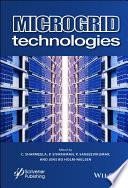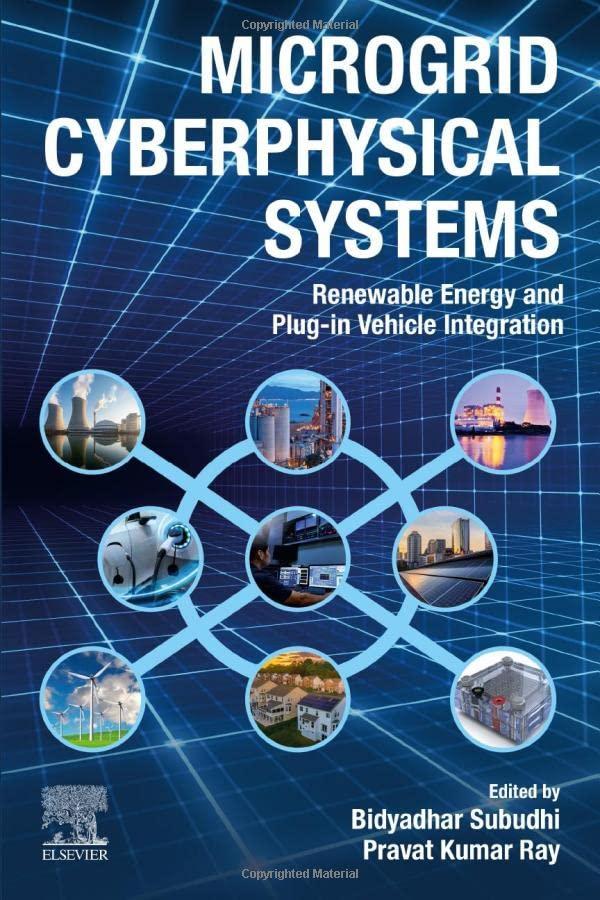Microgrid Technologies Sharmeela
Visit to download the full and correct content document: https://ebookmass.com/product/microgrid-technologies-sharmeela/

More products digital (pdf, epub, mobi) instant download maybe you interests ...

Microgrid Technologies C. Sharmeela
https://ebookmass.com/product/microgrid-technologies-c-sharmeela/

Control of Standalone Microgrid Anuradha Tomar
https://ebookmass.com/product/control-of-standalone-microgridanuradha-tomar/

Control of Power Electronic Converters with Microgrid Applications Arindam Ghosh
https://ebookmass.com/product/control-of-power-electronicconverters-with-microgrid-applications-arindam-ghosh/

Microgrid Cyberphysical Systems: Renewable Energy and Plug-in Vehicle Integration 1st Edition Bidyadhar Subudhi
https://ebookmass.com/product/microgrid-cyberphysical-systemsrenewable-energy-and-plug-in-vehicle-integration-1st-editionbidyadhar-subudhi/

Wastewater Treatment Technologies - Design Considerations
Mritunjay Chaubey
https://ebookmass.com/product/wastewater-treatment-technologiesdesign-considerations-mritunjay-chaubey/

Emerging Technologies in Engineering Mahesh P. K.
https://ebookmass.com/product/emerging-technologies-inengineering-mahesh-p-k/

Innovations in Fermentation and Phytopharmaceutical Technologies Hrudayanath Thatoi
https://ebookmass.com/product/innovations-in-fermentation-andphytopharmaceutical-technologies-hrudayanath-thatoi/

Fermentation Processes: Emerging and Conventional Technologies
Mohamed Koubaa
https://ebookmass.com/product/fermentation-processes-emergingand-conventional-technologies-mohamed-koubaa/

Biomimicry for Aerospace: Technologies and Applications Vikram Shyam
https://ebookmass.com/product/biomimicry-for-aerospacetechnologies-and-applications-vikram-shyam/

Table of Contents
Cover Title Page
Copyright Foreword Acknowledgements
1 A Comprehensive Review on Energy Management in Micro-Grid System
1.1 Introduction
1.2 Generation and Storage System in MicroGrid
1.3 System of Energy Management
1.4 Algorithms Used in Optimizing Energy Management System
1.5 Conclusion References
2 Power and Energy Management in Microgrid
2.1 Introduction
2.2 Microgrid Structure
2.3 Power Flow Management in Microgrid
2.4 Generalized Uni�ied Power Flow Controller (GUPFC)
2.5 Active GUPFC References
3 Review of Energy Storage System for Microgrid
3.1 Introduction
3.2 Detailed View of ESS
3.3 Types of ESS
3.4 Comparison of Current ESS on Large Scale
3.5 Importance of Storage in Modern Power Systems
3.6 ESS Issues and Challenges
3.7 Conclusion
Acknowledgment
References
4 Single Phase Inverter Fuzzy Logic Phase Locked Loop
4.1 Introduction
4.2 PLL Synchronization Techniques
4.3 Fuzzy Logic Control
4.4 Fuzzy Logic PLL Model
4.5 Simulation and Analysis of Results
4.6 Conclusion Acknowledgment
References
5 Power Electronics Interfaces in Microgrid Applications
5.1 Introduction
5.2 Microgrid Classi�ication
5.3 Role of Power Electronics in Microgrid Application
5.4 Power Converters
5.5 Conclusion
References
6 Recon�igurable Battery Management System for Microgrid Application
6.1 Introduction
6.2 Individual Cell Properties
6.3 State of Charge
6.4 State of Health
6.5 Battery Life
6.6 Rate Discharge Effect
6.7 Recovery Effect
6.8 Conventional Methods and its Issues
6.9 Series-Parallel Connections
6.10 Evolution of Battery Management System
6.11 Modeling of Recon�igurable-BMS
6.12 Real Time Design Aspects
6.13 Opportunities and Challenges
6.14 Conclusion
References
7 Load Flow Analysis for Micro Grid
7.1 Introduction
7.2 Load Flow Analysis for Micro Grid
7.3 Example
7.4 Energy Storage System
7.5 Connected Loads
7.6 Reactive Power Compensation
7.7 Modeling and Simulation
7.8 Conclusion
References
8 AC Microgrid Protection Coordination
8.1 Introduction
8.2 Fault Analysis
8.3 Protection Coordination
8.4 Conclusion Acknowledgment
References
9 A Numerical Approach for Estimating Emulated Inertia With Decentralized Frequency Control of Energy Storage Units for Hybrid Renewable Energy Microgrid System
9.1 Introduction
9.2 Proposed Methodology
9.3 Results and Discussions
9.4 Conclusion References
10 Power Quality Issues in Microgrid and its Solutions
10.1 Introduction
10.2 Classi�ication of Microgrids
10.3 DC Microgrid
10.4 AC Microgrid
10.5 AC/DC Microgrid
10.6 Enhancement of Voltage Pro�ile by the Inclusion of RES
10.7 Power Quality in Microgrid
10.8 Power Quality Disturbances
10.9 International Standards for Power Quality
10.10 Power Quality Disturbances in Microgrid
10.11 Shunt Active Power Filter (SAPF) Design
10.12 Control Techniques of SAPF
10.13 SPWM Controller
10.14 Sliding Mode Controller
10.15 Fuzzy-PI Controller
10.16 GWO-PI Controller
10.17 Metaphysical Description of Optimization Problems With GWO
10.18 Conclusion References
11 Power Quality Improvement in Microgrid System Using PSOBased UPQC Controller
11.1 Introduction
11.2 Microgrid System
11.3 Uni�ied Power Quality Conditioner
11.4 Particle Swarm Optimization
11.5 Simulation and Results
11.6 Conclusion
References
12 Power Quality Enhancement and Grid Support Using Solar Energy Conversion System
12.1 Introduction
12.2 Renewable Energy and its Conversion Into Useful Form
12.3 Power System Harmonics and Their Cause
12.4 Power Factor (p.f.) and its Effects
12.5 Solar Energy System With Power Quality Enhancement (SEPQ)
12.6 Results and Discussions
12.7 Conclusion
References
13 Power Quality Improvement of a 3-Phase-3-Wire Grid-Tied PVFuel Cell System by 3-Phase Active Filter Employing Sinusoidal Current Control Strategy
13.1 Introduction
13.2 Active Power Filter (APF)
13.3 Sinusoidal Current Control Strategy (SCCS) for APFs
13.4 Sinusoidal Current Control Strategy for ShPF
13.5 Sinusoidal Current Control Strategy for SAF
13.6 Solid Oxide Fuel Cell (SOFC)
13.7 Simulation Analysis
13.8 Conclusion References
14 Application of Fuzzy Logic in Power Quality Assessment of Modern Power Systems
14.1 Introduction
14.2 Power Quality Indices
14.3 Fuzzy Logic Systems
14.4 Development of Fuzzy Based Power Quality Evaluation
Modules
14.5 Conclusion
References
15 Applications of Internet of Things for Microgrid
15.1 Introduction
15.2 Internet of Things
15.3 Smart Micro Grid: An IoT Perspective
15.4 Literature Survey on the IoT for SMG
15.5 Cyber Security Challenges for SMG
15.6 Conclusion
References
16 Application of Arti�icial Intelligent Techniques in Microgrid
16.1 Introduction
16.2 Main Problems Faced in Microgrid
16.3 Application of AI Techniques in Microgrid
16.4 Conclusion
References
17 Mathematical Modeling for Green Energy Smart Meter for Microgrids
17.1 Introduction
17.2 Related Work
17.3 Proposed Technical Architecture
17.4 Proposed Mathematical Model
17.5 Results
Conclusion
References
18 Microgrid Communication
18.1 Introduction
18.2 Reasons for Microgrids
18.3 Microgrid Control
18.4 Control Including Communication
18.5 Control with No Communication
18.6 Requirements
18.7 Reliability
18.8 Microgrid Communication
18.9 Microgrid Communication Networks
18.10 Key Aspects of Communication Networks in Smart Grids
18.11 Customer Premises Network (CPN)
18.12 Architectures and Technologies Utilized in Communication Networks Within the Transmission Grid
References
19 Placement of Energy Exchange Centers and Bidding Strategies for Smartgrid Environment
19.1 Introduction
19.2 Local Energy Centers and Optimal Placement
19.3 Local Energy Markets and Bidding Strategies
Conclusion
References
Index
End User License Agreement
List of Figures
Chapter 1
Figure 1.1 The renewable global status report.
Figure 1.2 Consumption of renewable energy sources.
Figure 1.3 Intensi�ication of various energy sources from 1990 to 2040.
Figure 1.4 Various ranges of MG.
Figure 1.5 Components of micro-grid.
Figure 1.6 Micro-grid in Islanded mode.
Figure 1.7 Microgrid in Grid Connected mode.
Figure 1.8 Energy management methodology.
Chapter 2
Figure 2.1 Basic structure of microgrid (MG).
Figure 2.2 PAFC characteristics.
Figure 2.3 PAFC average cell voltage vs current density.
Figure 2.4 PAFC equivalent circuit.
Figure 2.5 Basic UPFC.
Figure 2.6 Basic GUPFC.
Figure 2.7 GUPFC equivalent circuit.
Figure 2.8 Proposed system.
Figure 2.9 Proposed system with grid connection.
Figure 2.10 Proposed system without grid connection.
Figure 2.11 Basic control of GUPFC compensator logic.
Figure 2.12 Basic control of series compensator logic.
Figure 2.13 Basic control of shunt compensator logic.
Figure 2.14 Simpli�ied test system.
Figure 2.15 Test system simulation.
Figure 2.16 IEEE 9 bus system.
Figure 2.17 IEEE 9 bus test system MATLAB simulation model.
Figure 2.18 Load voltage pro�ile in test case-1.
Figure 2.19 Load voltage pro�ile in test case-2.
Figure 2.20 Load voltage pro�ile in test case-3.
Figure 2.21 Load voltage pro�ile in test case-4.
Figure 2.22 Load voltage pro�ile in test case-5.
Figure 2.23 Summary of simulation: Percentage load voltage deviation from rated ...
Figure 2.24 Summary of simulation: Percentage load voltage deviation from rated ...
Figure 2.25 MAC 24 network diagram.
Figure 2.26 IEEE 9 bus test system.
Chapter 3
Figure 3.1 Load demand outline with ESS [11].
Figure 3.2 Application of ESS in a power system network [13].
Figure 3.3 (a) Aggregated system and (b) Distributed system.
Figure 3.4 ESS con�igurations with other devices.
Figure 3.5 Types of Mechanical ESS.
Figure 3.6 Flywheel based ESS con�iguration.
Figure 3.7 Structure of compressed air based ESS.
Figure 3.8 con�iguration of PHS system.
Figure 3.9 Detailed classi�ication chemical based ESS.
Figure 3.10 Functional diagram of HES.
Figure 3.11 Typical view of battery-based ESS.
Figure 3.12 Classi�ications of EES.
Figure 3.13 Functional diagram of SC-based ESS.
Figure 3.14 Typical view of SMES.
Figure 3.15 Types of thermal-based ESS.
Figure 3.16 Functional diagram of TESS.
Figure 3.17 Typical Hybrid ESS.
Chapter 4
Figure 4.1 Overall control structure of a single-phase gridconnected PV system.
Figure 4.2 Basic structure of the PLL.
Figure 4.3 Structure of the T/4 delay PLL.
Figure 4.4 Inverse Park Transform based PLL.
Figure 4.5 Enhanced PLL.
Figure 4.6 Phase Detector of the SOGI PLL.
Figure 4.7 Cascaded Generalized Integrator PLL (CGI-PLL).
Figure 4.8 Cascaded Delayed Signal Cancellation Phase Locked Loop (CDSC-PLL).
Figure 4.9 Basic Structure of Fuzzy Logic Controller.
Figure 4.10 Single input and single output Fuzzy Logic Control Structure.
Figure 4.11 Single input Membership function.
Figure 4.12 3 × 3 Fuzzy Logic Control Structure.
Figure 4.13 Membership function of 3 × 3 fuzzy set.
Figure 4.14 5 × 5 Fuzzy Logic Control Structure.
Figure 4.15 Membership function of 5 × 5 fuzzy set.
Figure 4.16 Rule base for single input fuzzy set.
Figure 4.17 Rule base for 3 × 3 fuzzy set.
Figure 4.18 Rule base for 5 × 5 fuzzy set.
Figure 4.19 Rule viewer for single input fuzzy set.
Figure 4.20 Rule viewer for 3 × 3 fuzzy set.
Figure 4.21 Rule viewer for 5 × 5 fuzzy set.
Figure 4.22 SOGI two inputs and one output FLC PLL structure.
Figure 4.23 SOGI two inputs and one output FLC PLL connected to a single phase i...
Figure 4.24 (a) Inverter output voltage compared with grid voltage, (b) Grid cur...
Figure 4.25 Test signal generator modelled in Matlab/Simulink.
Figure 4.26 Test signal generator connected to SOGI FLC PLL.
Figure 4.27 SOGI FLC PLL under no fault condition.
Figure 4.28 SOGI FLC PLL under 3rd and 5th harmonic conditions.
Figure 4.29 SOGI FLC PLL under 3rd and 5th harmonic with phase shift condition.
Figure 4.30 SOGI FLC PLL under pulse interference.
Figure 4.31 SOGI FLC PLL under modi�ied pulse interference.
Figure 4.32 SOGI FLC PLL under noise interference.
Chapter 5
Figure 5.1 Classi�ication of microgrids.
Figure 5.2 The typical con�iguration of an AC microgrid.
Figure 5.3 Typical power structure of a DC microgrid.
Figure 5.4 The power structure of hybrid microgrid.
Figure 5.5 Grid connected PV application: The DC–DC converter interface with MPP...
Figure 5.6 (a) Wind generator of Squirrel Cage Induction Generator or Permanent ...
Figure 5.6 (b) Wound Rotor Induction Generator with back–back converters.
Figure 5.7 Application of boost converter in grid connected PV application.
Figure 5.8 Typical I–V and P–V curves of a solar PV module.
Figure 5.9 Flow chart of Perturb and Observe MPPT algorithm.
Figure 5.10 Boost converter voltage and current waveforms.
Figure 5.11 Interleaved boost converter con�iguration.
Figure 5.12 Non-isolated step-down DC–DC converter.
Figure 5.13 Buck converter voltage and current waveforms.
Figure 5.14 Buck-boost converter con�iguration.
Figure 5.15 Isolated DC–DC converters: (a) Flyback, (b) Push–pull, (c) Half-brid...
Figure 5.16 DAB converter for isolated DC–DC conversion.
Figure 5.17 EV charging using bi-directional DC–DC converter.
Figure 5.18 Full wave diode recti�ier circuits: (a) using two diodes, (b) using ...
Figure 5.19 Output voltage waveforms: (a) without, (b) with DC-link capacitor.
Figure 5.20 PWM recti�ier or active recti�ier.
Figure 5.21 EV charging using bi-directional AC–DC converters: (a) without, (b) ...
Figure 5.22 PWM VSC for converting DC to AC. (a) Singlephase half-bridge, (b) s...
Figure 5.23 Control block diagram of three-phase VSC in reference frame.
Figure 5.24 (a) PWM output voltage waveform, (b) the harmonic spectrum. Chapter 6
Figure 6.1 Battery equivalent electric circuit.
Figure 6.2 Implantation of battery model in MATLAB/Simulink.
Figure 6.3 Existing topologies: (a) Series connection, (b) parallel connection, ...
Figure 6.4 First design having 5 switches per cell.
Figure 6.5 A series-connected recon�igurable battery pack.
Figure 6.6 A Self-X recon�igurable multi-cell battery pack.
Figure 6.7 Schematic diagram of DESA.
Figure 6.8 Genetic algorithm based topology.
Figure 6.9 Graph based topology and paths as graph representation.
Figure 6.10 4S con�iguration-based order of switching.
Figure 6.11 4S to 4P con�iguration-based faults occurring switches.
Figure 6.12 4P con�iguration-based order of switching.
Chapter 7
Figure 7.1 SLD of micro grid system.
Figure 7.2 SLD of micro grid in ETAP.
Chapter 8
Figure 8.1 A sample of islanding microgrid design.
Figure 8.2 Analyzing electrical component in positive, negative and zero sequenc...
Figure 8.3 Symmetrical fault diagram.
Figure 8.4 Three-Phase symmetrical fault sequence diagram.
Figure 8.5 Single line-to-ground fault diagram.
Figure 8.6 Single line-to-ground fault sequence diagram.
Figure 8.7 Line to line fault diagram.
Figure 8.8 Line-to-line fault sequence diagram.
Figure 8.9 Double line-to-ground fault diagram.
Figure 8.10 Double line-to-ground fault sequence components.
Figure 8.11 IEC Standard Inverse (SI) operating curve.
Figure 8.12 Directional characteristics for phase to ground fault.
Figure 8.13 Directional characteristics for double line to ground fault.
Figure 8.14 Typical distance protection quadrilateral operation settings.
Figure 8.15 Distance protection logic.
Figure 8.16 The quadrature distance protection test graph for phase to ground fa...
Figure 8.17 Distance trip time test graph for phase to ground fault.
Figure 8.18 The quadrature distance protection test graph for double line to gro...
Figure 8.19 Distance trip time test graph for double line to ground fault.
Figure 8.20 The distance accelerating scheme for OHTL between the microgrid and ...
Figure 8.21 Programing the acceleration scheme by the numerical protection relay...
Chapter 9
Figure 9.1 Block diagram of control strategy.
Figure 9.2(a) Overview of simulated Microgrid.
Figure 9.2(b) Architecture of single DG unit connected to a synchronous generato...
Figure 9.3 Frequency response for sudden load variation with less low penetratio...
Figure 9.4 Battery and supercapacitor power for sudden load change with less RES...
Figure 9.5 Normalized S.O.C graphs.
Figure 9.6 Governor response.
Figure 9.7 Change in solar power.
Figure 9.8 Frequency response for P.V. change.
Figure 9.9 Governor response for P.V change.
Figure 9.10 Normalized S.O.C graphs.
Figure 9.11 Frequency response for sudden load variation with high penetration o...
Figure 9.12 Battery and supercapacitor power for sudden load change with high RE...
Figure 9.13 Normalized SOC of battery and supercapacitor.
Figure 9.14 Governor response for sudden load change with high RES share.
Figure 9.15 Solar power variation.
Figure 9.16 Frequency response for PV.
Figure 9.17 Governor response.
Figure 9.18 Normalized S.O.C graphs.
Figure 9.19 Fuel cell active power variation for deloading technique.
Chapter 10
Figure 10.1 Schematic arrangement of Microgrid.
Figure 10.2 Structure of a DC microgrid.
Figure 10.3 Structure of AC microgrid.
Figure 10.4 Structure of hybrid microgrid.
Figure 10.5 33 bus microgrid.
Figure 10.6 Radial line power �low.
Figure 10.7 Voltage Pro�ile before RES inclusion.
Figure 10.8 Solar power generation.
Figure 10.9 Wind power generation.
Figure 10.10 Voltage Pro�ile after RES inclusion.
Figure 10.11 Voltage Pro�ile comparison.
Figure 10.12 Non-linear loads connected to DG’s.
Figure 10.13 (a) Current waveform distortion level with linear load. (b) Distort...
Figure 10.14 (a) Voltage waveform with non-linear load. (b) Distortion level of ...
Figure 10.15 (a) Current waveform with non-linear load. (b) Distortion level of ...
Figure 10.16 Microgrid connected with SAPF.
Figure 10.17 Generation of gating pulse with Fuzzy-PI controller.
Figure 10.18 GWO community ladder.
Figure 10.19 Flowchart for updating search agent in GWO.
Figure 10.20 (a) Current waveform with compensation. (b) Distortion level of cur...
Chapter 11
Figure 11.1 Structure of general Microgrid.
Figure 11.2 Basic diagram of wind turbine.
Figure 11.3 Flow chart representation of P&O technique.
Figure 11.4 DC–DC converter MPPT controller.
Figure 11.5 Single line diagram of UPQC.
Figure 11.6 Structure of proposed PSO based UPQC Series control diagram.
Figure 11.7 Control structure of the shunt inverter.
Figure 11.8 Algorithm for PSO technique.
Figure 11.9 Structure of Proposed Microgrid System with UPQC.
Figure 11.9 Simulation result for active and reactive powers with PI based UPQC.
Figure 11.10 Simulation result for Grid Voltage and Grid Current.
Figure 11.11 Analysis of the (a) Voltage swell, (b) Injected voltage and (c) Out...
Figure 11.12 Simulation result for active and reactive powers with PSO technique...
Figure 11.13 Simulation result for Grid Voltage and Current due to change in loa...
Figure 11.14 THD for Non-Linear Current without UPQC.
Figure 11.15 THD for Non-Linear Current with UPQC PI controller.
Figure 11.16 THD for Non-Linear Current with UPQC PSO controller.
Chapter 12
Figure 12.1 Block diagram of SECS.
Figure 12.2 Equivalent diagram of supply system having different loads.
Figure 12.3 Phase-A (a) bus voltage with linear load, (b) bus voltage with non-l...
Figure 12.4 Voltage spectrums with (a) linear load and (b) non-linear load and C...
Figure 12.5 Equivalent diagram of capacitor bank attached in parallel with laggi...
Figure 12.6 (a) Voltages and (b) currents with and without capacitor bank.
Figure 12.7 Equivalent diagram of SEPQ.
Figure 12.8 Flow chart for control of SECS in D-STATCOM mode.
Figure 12.9 (a) SEPQ current for mode-1.
Figure 12.10 (a) DC bus voltage, (b) active power of SEPQ, load and grid, and (c...
Figure 12.11 (a) SEPQ current for mode-2.
Figure 12.12 Grid current spectrum (a) without SEPQ and (b) with SEPQ.
Figure 12.13 (a) DC bus voltage, (b) active power of SEPQ, load and grid, and (c...
Figure 12.14 (a) SEPQ current for mode-3.
Figure 12.15 Grid current spectrum (a) without SEPQ and (b) with SEPQ.
Figure 12.16 (a) DC bus voltage, (b) active power of SEPQ, load and grid, and (c...
Chapter 13
Figure 13.1 Schematic diagram of ShPF.
Figure 13.2 Schematic diagram of SAF.
Figure 13.3 Physical signi�icance of instantaneous power in αβ0- frame.
Figure 13.4 Basic control strategy of 3-Phase 3-Wire ShPF.
Figure 13.5 Optimal Power Flow Provided by Shunt Current Compensation.
Figure 13.6 Control block of sinusoidal current control strategy with 3-φ ShPF.
Figure 13.7 Basic block diagram of 3-P-3-W Series Active Filter.
Figure 13.8 Control circuitry of series active �ilter.
Figure 13.9 System block diagram for shunt active �ilter.
Figure 13.10 System block diagram for series active �ilter.
Figure 13.11 Schematic diagram of a typical SOFC system.
Figure 13.12 Basic structure of SOFC.
Figure 13.13 (a) Source Voltage, (b) Source Current.
Figure 13.14 Load End Parameters: (a) Load Voltage, (b) Load Current.
Figure 13.15 Compensating waveforms of ShPF: (a) Shunt voltage, (b) Shunt curren...
Figure 13.16 DC link voltage.
Figure 13.17 FFT analysis of source current.
Figure 13.18 Injected current by shunt compensator of a PVgrid system.
Figure 13.19 PV-grid network: (a) Grid injected voltage (b) Grid injected curren...
Figure 13.20 Harmonic analysis of grid injected current waveform.
Figure 13.21 SOFC voltage.
Figure 13.22 Load voltage with SOFC.
Figure 13.23 Load current with SOFC.
Figure 13.24 Grid injected voltage.
Figure 13.25 Load voltage waveform.
Figure 13.26 Series inverter injected voltage.
Figure 13.27 Harmonic analysis of load voltage.
Figure 13.28 Grid current waveform.
Figure 13.29 THD of Grid current.
Figure 13.30 Grid injected: (a) Source voltage, (b) Source current.
Figure 13.31 PV inverter output: (a) Voltage (b) Current.
Figure 13.32 (a) Load voltage (b) Load current.
Figure 13.33 Inverter voltage output with SOFC and SAF.
Figure 13.34 Inverter current output with SOFC and SAF.
Chapter 14
Figure 14.1 (a) Fundamental and other harmonics of a sinusoidal waveform, (b) Co...
Figure 14.2 Block diagram of fuzzy logic system.
Figure 14.3 Single phase AC voltage controller circuit with resistive load.
Figure 14.4 Block diagram of FTDDF module.
Figure 14.5 Representation of input and output variables for FTDDF module.
Figure 14.6 TDD and FTDDF values for sinusoidal condition (a) SC level 17.7, (b)...
Figure 14.7 TDD and FTDDF values for nonsinusoidal condition (a) SC level 17.7, ...
Figure 14.8 Block diagram of RQPF module.
Figure 14.9 Representation of input and output variables for RQPF module.
Figure 14.10 Circuit considered for demonstrating performance of FRQPF.
Figure 14.11 FRQPF values for different loading cases (a) Sinusoidal voltage sou...
Figure 14.12 Block diagram of the fuzzy power quality index evaluation module.
Figure 14.13 Representation of THD and FPQI variables for FPQI module.
Figure 14.14 Single-phase nonlinear load supplied from sinusoidal source.
Figure 14.15 FPQI, FRQPF and FTDDF values (a) Sinusoidal case, (b) Nonsinusoidal...
Chapter 15
Figure 15.1 The microgrid operational diagram.
Figure 15.2 The operational modes of the microgrid.
Figure 15.3 The block diagram of the smart micro grid.
Figure 15.4 The IoT-based smart microgrid system.
Figure 15.5 The Cloud computing application for IoT-based smart microgrid system...
Chapter 16
Figure 16.1 Microgrid with hybrid AC/DC power sources and power electronic conve...
Figure 16.2 Evolution of PQI devices.
Figure 16.3 Two area LFC system with interconnected tie-line.
Figure 16.4 Power control circuit of VSI fed DG unit of microgrid.
Figure 16.5 Energy storage system in microgrid.
Figure 16.6 Intelligent approaches in energy storage system in microgrid.
Figure 16.7 Energy management with microgrid central controller.
Chapter 17
Figure 17.1 Example of microgrid system [6].
Figure 17.2 MPPT algorithm [1].
Figure 17.3 Technical architecture for a green energy smart meter for solar powe...
Figure 17.4 Flowchart of mathematical model.
Figure 17.5 Green Energy Smart Meter circuit diagram.
Figure 17.6 Energy over time.
Figure 17.7 Power over time.
Figure 17.8 Voltage over time.
Figure 17.9 Current over time.
Figure 17.10 Energy, power, voltage and current over time.
Chapter 18
Figure 18.1 Microgrid communication systems.
Chapter 19
Figure 19.1 Smart grid Environment.
Figure 19.2 (a) Scatter plot of prosumers. (b) Scatter plot of generators.
Figure 19.3 (a) Scatter plot of Prosumers. (b) Scatter plot of generators.
Figure 19.4 (a) Scatter plot of prosumers. (b) Scatter plot of generators.
Figure 19.5 (a) Plot of DMF for Np = 1,000, Ng = 7. (b) Cluster plot for optimal...
Figure 19.6 (a) Plot of DMF for Np = 2,000, Ng = 23. (b)
Cluster plot for optima...
Figure 19.7 (a) Plot of DMF for Np = 4,000, Ng = 25. (b) Cluster plot for optima...
Figure 19.8 Flowchart.
Figure 19.9 IEEE 33 Bus System [20].
Figure 19.10 (a) Voltage Pro�ile at each bus. (b) Active power loss plot.
List of Table
Chapter 2
Table 2.1 Fuel cell resource comparison (courtesy: DOE, US Government).
Table 2.2 Test system simulation events.
Table 2.3 MAC 24 network parameters.
Table 2.4 IEEE 9 bus test system branch data.
Chapter 3
Table 3.1 Properties, merits, and demerits of modern batterybased ESS [6].
Table 3.2 Merits and demerits of various storage devices [25].
Chapter 4
Table 4.1 Test parameters for test case 4.
Table 4.2 Test parameters for test case 5.
Chapter 6
Table 6.1 Comparison of various recon�igurable topologies properties.
Chapter 7
Table 7.1 Rating of micro grid.
Table 7.2 Name plate details of solar inverter.
Table 7.3 Name plate details of BESS inverters.
Table 7.4 Various operating conditions of micro grid.
Table 7.5 Bus voltage, real power and reactive power.
Table 7.6 Circuit components loading.
Table 7.7 Bus voltage, real power and reactive power.
Table 7.8 Circuit components loading.
Table 7.9 Bus voltage, real power and reactive power.
Table 7.10 Circuit components loading.
Table 7.11 Bus voltage, real power and reactive power.
Table 7.12 Circuit components loading.
Table 7.13 Bus voltage, real power and reactive power.
Table 7.14 Circuit components loading
Chapter 8
Table 8.1 ANSI inverse curves constant values.
Table 8.2 The quadrature distance test result values for phase to ground simula...
Table 8.3 Test result trip time values for phase to ground fault simulation.
Table 8.4 The quadrature distance test result values for double line to ground ...
Table 8.5 Test result trip time values for double line to ground fault simulati...
Chapter 9
Table 9.1 Tabular brie�ing of different methods for frequency support.
Table 9.2 Equivalent synchronous generator design parameters.
Table 9.3 Network parameters considered for modeling system.
Table 9.4 System inertia calculation for 30% change in loading condition.
Table 9.5 System inertia calculation for 30% change in loading condition.
Table 9.6 Dynamics of fuel cell active power set points.
Table 9.7 Modi�ied active power requirements due to decentralize control.
Chapter 10
Table 10.1 Types of Microgrid based on the power handling capacity.
Table 10.2 MG Demand and impedance value.
Table 10.3 Harmonic orders and THD levels.
Table 10.4 THD and measured power factor.
Table 10.5 Individual phase percentage THD.
Chapter 11
Table 11.1 System parameters for wind turbine system.
Table 11.2 System parameters.
Chapter 12
Table 12.1 System details for harmonics analysis.
Table 12.2 System details for p.f. analysis.
Chapter 13
Table 13.1 Brief analysis of various FCs.
Table 13.2 Load parameters (ShPF).
Table 13.3 Simulation parameter.
Table 13.4 Simulation parameter of SOFC.
Table 13.5 Simulation parameters.
Table 13.6 Circuit parameters.
Table 13.7 Validation table for ShPF.
Table 13.8 Validation table for SAF.
Chapter 14
Table 14.1 Harmonic current distortion limit as per IEEE519:2014.
Table 14.2 Rule base for FTDDF module.
Table 14.3 Rule viewer output of FTDDF module for two cases.
Table 14.4 Rule viewer output for Ideal and Nonideal cases of RQPF module.
Table 14.5 Seven different loading cases considered for FRQPF evaluation.
Table 14.6 Rule viewer output of FPQI module.
Table 14.7 Evaluation of FPQI from three stages under sinusoidal situations.
Table 14.8 Evaluation of FPQI from three stages under nonsinusoidal situations.
Chapter 15
Table 15.1 The variations among traditional grid and smart micro grid.
Table 15.2 Advanced technologies for implementing SG.
Table 15.3 Cyber security standards for SG.
Chapter 17
Table 17.1 Energy consumed over time.
Chapter 19
Table 19.1 Prosumer parameter values.
Table 19.2 Power and revenue of prosumers.
Table 19.3 Bids of three prosumers.
Table 19.4 Updated power and revenue of prosumers.
Table 19.5 Hiking the bid price of 3rd prosumer.
Table 19.6 Expected payoff of three prosumers based on updated bidding strategy...
Table 19.7 Power and revenue in two prosumer case.
Table 19.8 Strategic bid for the four-prosumer case.
Table 19.9 Power and revenues of four prosumers.
Scrivener Publishing
100 Cummings Center, Suite 541J
Beverly, MA 01915-6106
Publishers at Scrivener
Martin Scrivener (martin@scrivenerpublishing.com)
Phillip Carmical (pcarmical@scrivenerpublishing.com)

